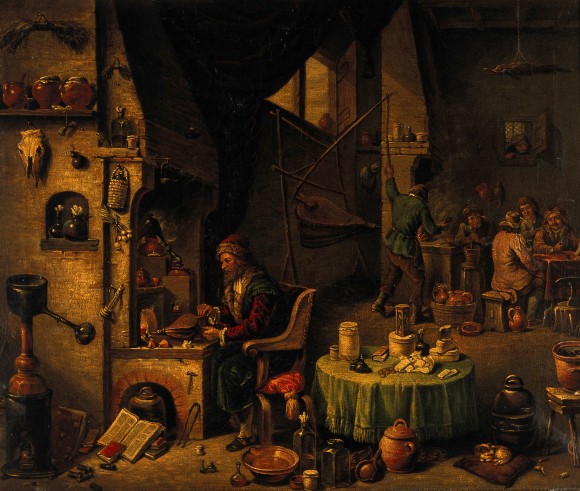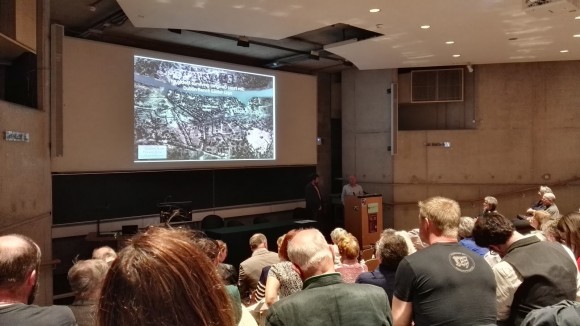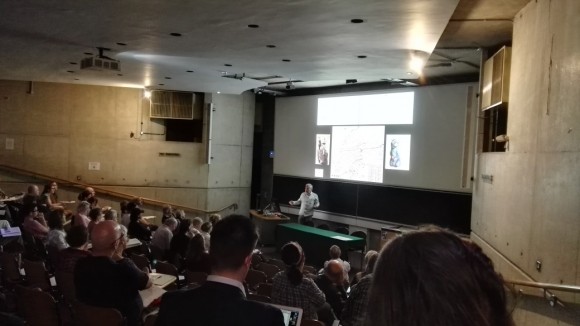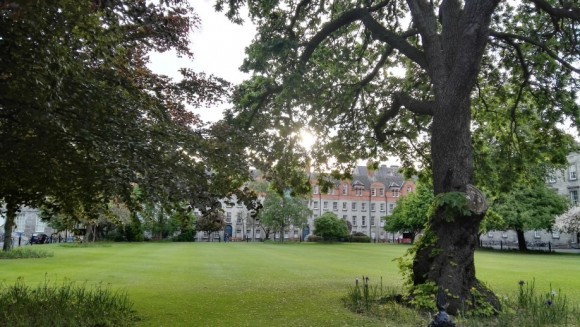NEWS ITEM: A BLAST FROM THE PAST
REVIEW OF THE 20TH MEDIEVAL DUBLIN SYMPOSIUM
Saturday 19 May, 2018
It was a sunny and busy Saturday on May 19th and the symposium competed for attention with the pomp and pageantry of a royal wedding, as well as an exciting F.A. Cup final (in which an Edan Hazard penalty won Chelsea the Cup and denied the Red Devils’ Jose Mourinho victory over his former club). And yet, the crowds packed into the J. M. Synge theatre in Trinity College’s Arts Block to learn more about the history and archaeology of medieval Dublin.
The assembled audience were treated to a fascinating array of studies of the history of Dublin which offered new insights into the medieval and, at times, post medieval city. Professor Seán Duffy, chairman of the Friends of Medieval Dublin, is the powerhouse behind the symposium – now in its 20th year – and deserves great credit for his unwavering dedication and attention to the medieval history of our capital city. The level of continued interest in the symposium is a credit to Seán, and so too is the annual publications of the symposium’s proceedings, the Medieval Dublin series, which remains a key vehicle for communicating cutting-edge historical and archaeological research on medieval Dublin.
ALAN HAYDEN
Alan Hayden opened proceedings with his fascinating paper ‘Everything but the apothecary: recent archaeological excavations on Kevin Street’. His talk provided an account of an archaeological excavation 400m to the south of the walled medieval city. The site yielded some very rare and interesting finds such as evidence for the abandonment of intensive settlement because of the de Bruce attack and Black Death in the 14th century, the partial remains of a late 17th-century brick mansion and the perhaps most complete skeleton of an Irish horse dating to c. 1700 yet found.
However, the most interesting find uncovered was the partial contents of a seventeenth-century apothecary’s shop, which is of considerable interest to those who work on late medieval to early modern Dublin and on the history of medicine. The discovery of so much of the contents of an apothecary’s shop is unprecedented, and as a result knowing how ‘complete’ the range of artefacts is from such a site is difficult. Thus, offering an interesting example of the potential for and value of interdisciplinary research which mixes archaeology and art history, Alan demonstrated the evidence of apothecary shops and workshops to be found in 17th-century Dutch genre painting was of value to understanding his archaeological findings. He showed us how, in this way, he could find parallels of almost all the finds in seventeenth-century technicolour!
Such a wide range of apothecary-related finds is unparalleled from any excavation, and he posited that we are looking at a collection of working vessels (bar those made of metal), including, glass medicine bottles, scientific glass and pottery vessels, bentwood box containers, drug and ointment jars etc, from this Dublin apothecary shop. Alan further suggested that the main thing missing from the assemblage was the apothecary himself, but he might have been a Dutchman Jacob Ryckman who had his premises in St. Kevin’s Parish in the 1640s!
AISLING COLLINS
Our second paper was especially interesting for those in the audience who had the pleasure of exploring the visitor centre of the Pearce Lyon Distillery for the recent joint book launch of Áine Foley’s volume on St Thomas’ Abbey published by Dublin City Council and Medieval Dublin XVI (Battle of Clontarf edition) ed. Seán Duffy – and this paper offered an insight into the construction of the distillery on a medieval site. Aisling Collins presented on a different face of archaeology to Alan Hayden’s paper, explaining how the regeneration of Pearse Lyons Distillery offered a rare and wonderful opportunity to explore, record, and preserve Dublin’s medieval heritage in that old part of the city.
In her paper, ‘St James’s Church and graveyard excavations’, she explained her role as project manager of development on this significant medieval site. Given the nature of the development, and with three churches on the site – the earliest dating to the 12th century – there was plenty for the archaeologists and developers to grapple with, but they were focused not on large-scale excavation, but on trying to preserve the burials intact and as undisturbed as possible. This protection of the heritage and the construction of the visitor centre has allowed us to get a glimpse into the fabric of medieval Dublin but at the same time to explore the best ways to protect the archaeological material while allowing for development. Aisling explained the historical significance of the site, and its connection to Henry Tyrell who donated land to St James’, and examined some of the findings from the site such as fragments of medieval pottery.
THOMAS W. SMITH
The morning break was followed by Thomas W. Smith’s fascinating and erudite paper, ‘Papal provision to ecclesiastical benefices in 13th century Dublin’. If you thought medieval Dublin was wholly beholden to the papacy, as it is sometimes assumed to have been, you can think again!
In his talk Tom set Dublin in an international context, and argued for the importance of the city in understanding how the practice of papal provision evolved over the course of the 13th century. He showed that Dublin was unusual in that, unlike England and other parts of Europe, and even other parts of Ireland, it had very few papal provisions despite the temptingly high value of some of the benefices in the archdiocese.
Tom contended that the most probable reason for this was that the English crown exercised a stranglehold on provisions to benefices in Dublin, and was able to protect its powers of provision to ensure that royal favourites were in place, particularly in the rich livings associated with St Patrick’s Cathedral. The crown prioritised Dublin in this way because it was crucial to have trusted and trained royal servants in benefices in the city at the heart of the English colony.
This paper provides a significant contribution to the debate surrounding papal privileges generally, shedding light on the evolution of papal provision in the medieval period, but it also contributes new insights into royal strategies for governing the colony and the centrality of Dublin to those strategies.
ANTOINE GIACOMETTI
The next paper of the day was a very engaging and informative talk by Antoine Gicometti, detailing his excavation of a large archaeological site just southwest of St Patrick’s Cathedral. In ‘Blackpitts: Dublin’s medieval tanning quarter’, Antoine led the audience through the site, using wonderful site maps, illustrations, and photographs (but thankfully not smells, which by his account, were truly awful).
Indeed, one memorable aspect of the talk was its attention to the unsavoury odours of the tanning pits: even after hundreds of years the hen and dog droppings or urine that was used on hides still smells, and can tell archaeologists which mixtures were favoured for different pits. Our special thanks must go to Antione and his team for conducting these unpleasant smell tests for the sake of knowledge!
Another of the intriguing aspects of the excavation was the evidence for continuous tanning activity on the site from the 13th-17th centuries, with over a hundred tanning pits preserved. These pits varied in morphology depending upon which stage of the tanning process they were used in, but, interestingly, their form changed little over 400 years. This remarkable continuity in tanning techniques and in the continued existence of a tanning quarter on this site helps, as Irish archaeology has often done, to disrupt and question that traditional historical divide between the medieval and early modern periods. The bone assemblage on the site was intriguing, as the jointed ends of cattle long bones were unearthed in some numbers, while the long, smooth middle sections were absent. Antione argued that those middle portions of the bone may have been passed onto local boneworkers, indicating the ways in which tanning interacted with and may have helped support other industry in the city.

STEPHEN HEWER
After lunch the symposium resumed with Stephen Hewer’s paper on an extremely significant source and a rare survival from the late thirteenth century: ‘The oldest surviving (original) court roll: Dublin Bench Easter 1290’. This roll, now housed in the British Library, escaped the destruction of the Irish archives in 1922.
An interesting mystery Stephen alluded to in his talk is the question of how the roll was purchased by the British Library, since it was recorded as being in the Irish archives in the early 19th century. The history of the roll in the post-medieval period is part of Stephen’s ongoing research on this remarkable source, which he has transcribed and plans to translate and publish. Stephen guided the audience through the roll, using ample attractive images, and commenting on the physical condition and areas of damage on each ‘rotulet’ (each of the parchment sheets that are sewn together to make the roll), as well as their contents.
The roll contains the record of legal judgements, as we might expect, but also a great deal of other material relating to litigation before the Bench and even, more surprisingly, some letters of the Irish chancery. The record of requests for better writs (to suit a given plaintiff’s case), of agreements or ‘concords’ reached between litigants before judgement, of defendants who did not appear and the appointments of attorneys all appear in the roll.
Among a number of important findings relating to the roll’s contents, Stephen identified several Gaelic Irish litigants before the Bench, which may come as a surprise to many who have understood that the Irish were excluded from seeking justice in royal courts in the colony in this period. This reveals a more nuanced picture of the legal landscape of the colony in the late 13th century and the place of the Gaelic Irish in it, and Stephen commented upon distinctions between ‘freedom’ and ‘enfranchisement’ of the Gaelic Irish.
Sadly, in many cases, we do not know the outcome of the pleas mentioned in the roll. This is both because of extensive damage of various kinds to the roll that prevents some of the entries from being entirely legible, and to the fact that many cases were only mentioned briefly to record that the defendants did not appear or to essoin the litigants (that is, record their excuses for not appearing in court) and delay the progress of the case to the next sitting of the bench.
One legal expert in attendance remarked that it seemed that little progress has been made in the Dublin legal scene since then and things are forever adjourning!
All in all, there is a wealth of information in this fascinating roll about the Dublin bench itself, and about the wider legal world of the colony.
EDMOND O’DONOVAN
Our next paper, by Ed O’Donovan, brought us back to archaeology, detailing his recent excavation of an interior courtyard within the Bank of Ireland on College Green, formerly the Parliament of Ireland. Ed began by orienting the audience and putting the site in its proper context, using a range of maps, images, and historical sources to lead the audience on a tour of Dublin’s eastern suburbs in the medieval and early modern periods.
His discussion of the famed Hiberno-Norse Thingmote, now flattened and lying beneath O’Neill’s pub on Suffolk St, was particularly interesting, as were his comments about the pathways marked on early modern maps, leading east from the city walls. Ed’s commentary about the orientation of property plots near the church of St Andrew (on Suffolk St) provided enlightening insights into the streetscape of Dublin, and the ways that ecclesiastical buildings shape the streets and buildings around them, often reflecting their east/west orientation.
In this way, the medieval landscape underlies and is mapped onto the modern city.
Across College Green, at the site itself, Ed’s excavation of a courtyard nicknamed ‘the swimming pool’ revealed several interesting features and artefacts. A rectangular building uncovered there dates from the 17th century or earlier, predating the current Parliament building and could be associated with an earlier Parliament building, or with Carey’s hospital, an early modern charitable institution dedicated to caring for sick or injured soldiers. An early modern well found on the site is contemporary with the building and may have been associated with drainage, rather than accessing drinking water, as it was brackish and tidal, being located so close to the Liffey.
A sole medieval artefact – a piece of Saintonge pottery – was also found on the site, though, as is so often the case, we can only speculate about what it was doing there!
Ed’s paper not only provided the audience with a tantalising glimpse into the monumental Bank of Ireland building and what lies beneath it, but also gave a memorable and enjoyable tour of the medieval city’s eastern suburbs.

PAUL DUFFY
Paul Duffy’s paper on the large and very exciting excavation of the site of Frawley’s on Thomas Street was the first after our final break, ‘Saints and skinners: results of archaeological excavations at 30 & 32-36 Thomas Street’.
Paul and his team uncovered a vast array of fascinating archaeological remains from the medieval period on this site, including some 7000 artefacts – bone, ceramic, tile, glass, and metal – and 112 burials. The site straddled the boundary of the Abbey of St. Thomas the Martyr and excavations identified the location of the northern wall of the abbey, which survives in a long stretch (probably dating from the 13th century).
To the north of this wall lay the site of a tannery, which was in use for hundreds of years in the medieval into the early modern period and was evident archaeologically from a multitude of pits, staining and salt in the soil, and artefacts including animal bone and wooden paddles for stirring the tanning liquid. The presence of a great deal of cow bone from small animals – probably juveniles – raises the possibility that vellum was produced here, perhaps for the abbey itself.
Other particularly striking finds include imported English pottery with decorative heads and glaze and a range of decorated floor tiles.
To the south of the Abbey’s wall lay part of the institution’s cemetery, which was the final resting place of lay Dubliners as well as religious from the Abbey; there are a number of female burials and some 30% of the burials were children. A number of the burials tell us something about the lives of the people interred; some were pilgrims, identified by their burial with scallop shells, while others were buried with stones inserted into their mouths. The meaning of this remains mysterious, but it was done deliberately and presumably with some symbolic intention.
Paul also uncovered evidence of iconoclasm, as some stone figures that would have decorated the abbey were deliberately defaced, perhaps during the period of the disillusion. The finds from this site thus provide illuminating windows into secular and religious life in Dublin’s thriving western suburb from the 12th all the way up to the 16th century.
FRANC MYLES
Franc Myles’s talk, ‘On the tiles at Keysars Lane: excavations at St Audoen’s’, was the last of the day. This paper discussed the ongoing ‘keyhole investigation’ at the wonderful medieval church of St Audoen because of recent construction work, and the unexpected discoveries the archaeologists are unearthing at the site.
The ongoing nature of this work meant that we were offered a rare glimpse into work-in-progress as the team endeavours to preserve archaeological features while managing the alterations to the site. We were again treated to a time-travelling slideshow which traced how the streetscape in this area has changed, utilising sources familiar to medieval Dublin enthusiasts like Speed and Roque’s maps, as well as less well-known modern images of the area, prior to recent demolitions and alterations, which hold clues to the medieval past.
Of particular interest were the finds of over 300 tiles of various design, including a vast array of two-colour floor tiles dating from the 13th to 16th century. Some of these probably date from the 14th century, when the church was undergoing significant alteration. One particularly decorative floor tile – with an impression of a man yielding a sword – graces this year’s symposium poster.
It is not just streetscapes which change over time, and Franc explained how street names near St Auoden’s church are rendered differently in different sources: Kisher’s Lane (1381), Kysser’s Lane (1400), Kisshoke’s Lane (1482) etc right up until our modern rendering of Keysars Lane on the 1837 Ordinance Survey.
Situated so close to Cook street, the presence of ovens at the site was intriguing, Franc explained that the area is separate from that street where medieval Dubliners cooked outside the city walls, and suggested that the ovens were probably domestic garden-ovens – and hinted that after processing environmental samples the team might know more – a good reason to look forward to a published account of Franc’s findings!

The day finally drew to a close and at least some of the assembled took themselves away off home to catch up on highlights of Mourinho looking glum and the Hollywood marriage that had taken place in London. Others retired to a nearby hostelry to digest the day’s proceedings or flick though newly-acquired books from Four Courts Press’ bookstall. The symposium is over for another year, but we hope to see you at another Friends event soon!





